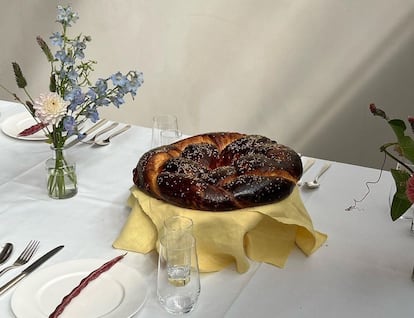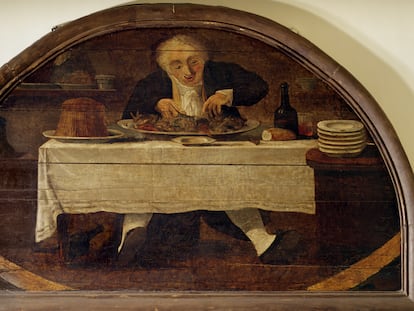Tablescape, or how the pandemic has brought back the art of setting the table
With a retro wink, here come candles, crochet table runners, silver trays, and mountains of butter, croquembouche (and even Spanish omelet) as edible sculpture

At the table, our attention is not only paid to what’s on our plate. By choosing the proper type of tableware, linen, cutlery and other decorative elements, it is possible to create a theme, even a landscape. With a retro wink, here come candles, crochet table runners, silver trays and mountains of butter, croquembouche (and even Spanish omelet) as edible sculpture. The art of setting the table is more fashionable than ever, and these days it’s called tablescape.
“A tablescape is a beautifully curated culinary experience, normally on a large table where food is served communally. It requires accessories, decoration and, normally, a theme,” explains Charlotte Forsyth Wastell and Sofie Thompson, who, via their events company Hands London, design tables where companies like Ferragamo and Veja sit down to dine.
The trend, which has been cooking on a low flame for a few years, began to boil during the pandemic. Not being able to go out to eat at restaurants inspired artists, stylists, designers and other aficionados of gastronomy and aesthetic to turn their tables into interesting, beautiful and of course, delicious displays. The experience of dining at a restaurant was brought into their homes, where familiarity with and control of all the decorative elements helped to bring the game to the next level. Here were the extravagant and baroque touches that had been eschewed from the table in the face of the Nordic minimalism that has seduced us over the last decade, which eliminated the use of the tablecloth in fine dining establishments in favor of the naked texture of marble, wood or metal.
“We missed eating in restaurants. Our response to lockdown was cooking at home, and turning dinner into something sumptuous and elaborate, with meals that were decorative with silver cutlery, antique objects, crochet table runners, and draping tablecloths. We always photographed those dinners, and soon enough people began asking us to open them up to the public,” say Forsyth Wastell and Thompson.
Julia Khan Anselmo began her project Feisty Feast in 2014. Her idea: to fill a table with women who would, face to face, explore questions surrounding feminism through food and other important themes. Khan Anselmo says that thanks to the pandemic, it’s become fashionable to pay attention to details at the table. “We have all spent a lot of time at home and we’ve even invested in tableware and other elements to create more special moments.” Her style, which she defines as “romantic and clean, without being too cloying,” is inspired by “the ancient world and everything that has withstood the passage of time” and places food at the center of it all. “I don’t like to gild the lily, and try to be playful and creative with things I already own. At the end of the day, the dishes are the protagonists.”
Both the impact of lockdown and the role of social media in our lives have been the determining factors in this resurgence of the art of setting the table. “Eating together is a universal experience and a simple form of expressing our love. Whether it’s for a partner or a friend, we put all our affection into cooking a meal and a well-planned plating. We think that Instagram has played a big role in our generation: we want our day-to-day items, like food, to be pleasurable and beautiful experiences on which attention has been spent,” say Forsyth Wastell and Thompson.
“Setting the table in a detailed manner has been a trend since the moment in which the table became a central element in human interaction, very attractive and visual,” says Monika Varšavskaja. Her training in art, design and photography, coupled with her interest in gastronomy, has led her to learn more about cooking to be able to bring together visual and culinary elements as an art and food director of gastronomic experiences for cosmetic brands and fashion magazines.
Some elements stand out for their increasingly popularity among tablescapes. Everyone who was interviewed for this article mentioned butter sculptures as a major trend, and each one pinpointed other ubiquitous items: for Varšavskaja, these are candleholders made from fruits and vegetables; for Forsyth Wastell and Thompson, braided loafs of bread and deviled eggs, “simple products that become beautiful and playful”; for Khan Anselmo, they are towers and sculptures made of fruits and cookies, “the abundant is in vogue and we’re moving away from the minimalism and restraint of the past few years towards the decadent, the over-the-top and the extravagant. It’s a fun, experimental and refreshing moment for me, one in which there are no rules.”
Sign up for our weekly newsletter to get more English-language news coverage from EL PAÍS USA Edition
Tu suscripción se está usando en otro dispositivo
¿Quieres añadir otro usuario a tu suscripción?
Si continúas leyendo en este dispositivo, no se podrá leer en el otro.
FlechaTu suscripción se está usando en otro dispositivo y solo puedes acceder a EL PAÍS desde un dispositivo a la vez.
Si quieres compartir tu cuenta, cambia tu suscripción a la modalidad Premium, así podrás añadir otro usuario. Cada uno accederá con su propia cuenta de email, lo que os permitirá personalizar vuestra experiencia en EL PAÍS.
¿Tienes una suscripción de empresa? Accede aquí para contratar más cuentas.
En el caso de no saber quién está usando tu cuenta, te recomendamos cambiar tu contraseña aquí.
Si decides continuar compartiendo tu cuenta, este mensaje se mostrará en tu dispositivo y en el de la otra persona que está usando tu cuenta de forma indefinida, afectando a tu experiencia de lectura. Puedes consultar aquí los términos y condiciones de la suscripción digital.
More information
Archived In
Últimas noticias
Most viewed
- Reinhard Genzel, Nobel laureate in physics: ‘One-minute videos will never give you the truth’
- Oona Chaplin: ‘I told James Cameron that I was living in a treehouse and starting a permaculture project with a friend’
- Pablo Escobar’s hippos: A serious environmental problem, 40 years on
- Why we lost the habit of sleeping in two segments and how that changed our sense of time
- The fall of a prolific science journal exposes the billion-dollar profits of scientific publishing









































